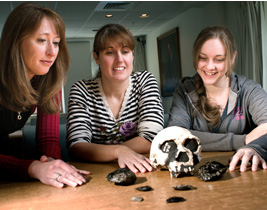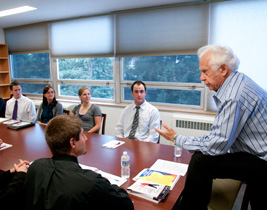Mountains & Minds: Learners and Leaders
Integration
Goal:
By integrating learning, discovery and engagement, and by working across disciplines, the MSU community will improve the world.
Objective I.1: Increase the integration of learning, discovery and engagement.
Metric I.1.1: By 2019, all graduating students will have had a substantial curricular experience that integrates learning, discovery and engagement.
Technical note: A substantial curricular experience means a credit-bearing course or program in which the student, with the guidance and supervision of a faculty advisor, will learn, discover, and engage in a sustained manner involving observation, critical thinking, creativity, and introspection. The experience culminates in the student producing a formal scholarly product that is discussed with and critically reviewed by the supervising faculty advisor. Courses with qualifying experiences must be designated.
Metric I.1.2:By 2019, department role and scope documents will include substantial integration of learning, discovery and engagement.
Technical note: Each college and department's Role, Scope, Criteria, Standards and Procedures document shall define the meaning of "substantial integration of learning, discovery and engagement" in the context of the college or department and shall describe how such integration is assessed and valued for purposes of promotion and tenure as well as annual reviews. Such description shall include the value placed on interdisciplinary teaching and research.
Metric I.1.3: By 2019, community-based research projects will increase by 50 percent.
Technical note: These data will need to be collected from a faculty activity reporting system.
Metric I.1.4: By 2019, faculty scholarly products with undergraduate and graduate students will increase 50 percent.
Technical note: This is not currently collected systematically. Faculty will need to identify and report these. The information might come from a faculty activity reporting system.
Objective I.2: Increase work across disciplines.
Metric I.2.1: By 2019, the number of students completing interdisciplinary programs will increase 30 percent.
Technical note: Completing an interdisciplinary program means that the student:
-
- Earns an undergraduate major or graduate degree in a field determined to be interdisciplinary.
- Earns a second major or a second degree in a different department than the first major or degree.
- Earns a minor in a different department than the major.
- Earns an interdisciplinary minor, which generally means a minor created to be interdisciplinary, or in a field that does not have a major.
Degrees and certificates awarded in identified majors are reported here: http://www.montana.edu/opa/facts/GradsByYear.html
Metric I.2.2: By 2019, MSU will increase interdisciplinary research and creative projects on campus.
Technical note: Interdisciplinary research and creative projects are research or creative projects that "integrate[] information, data, techniques, tools, perspectives, concepts, and/or theories from two or more disciplines or bodies of specialized knowledge to advance fundamental understanding or to solve problems whose solutions are beyond the scope of a single discipline or area of research practice." http://www.nsf.gov/od/iia/additional_resources/interdisciplinary_research/definition.jsp
Measurable outputs include, but are not necessarily limited to, grant proposals, presentations, published articles, books, book chapters, monographs, juried exhibitions, performances, and compositions. This information may be designated on all intellectual contributions reported in Activity Insight.

Archeology students help research, write and design an exhibit featuring ancient artifacts excavated by the famous archaeologists Mary and Louis Leakey.

Student entrepreneurs collaborate with students in other disciplines such as engineering, the sciences, agriculture, graphic arts and the humanities.
